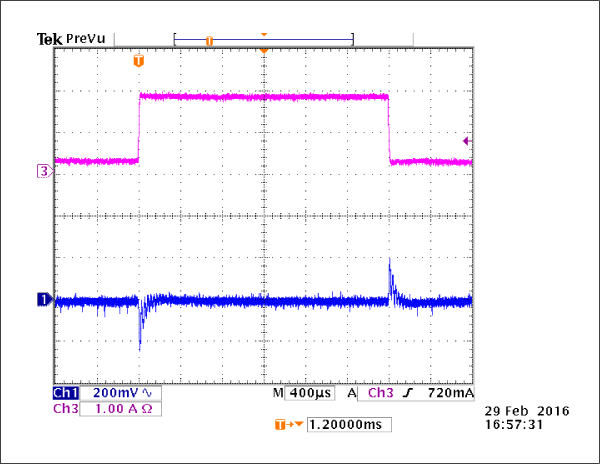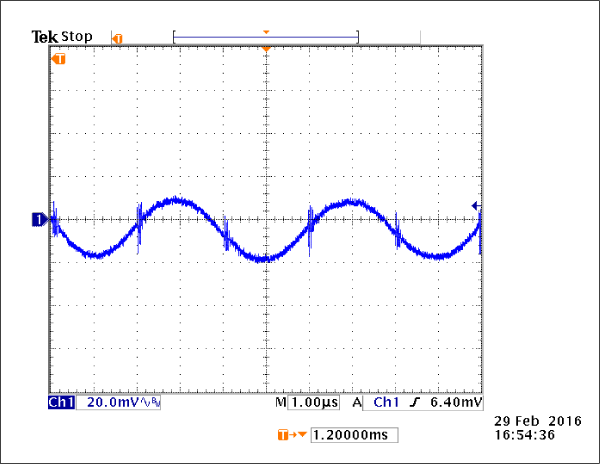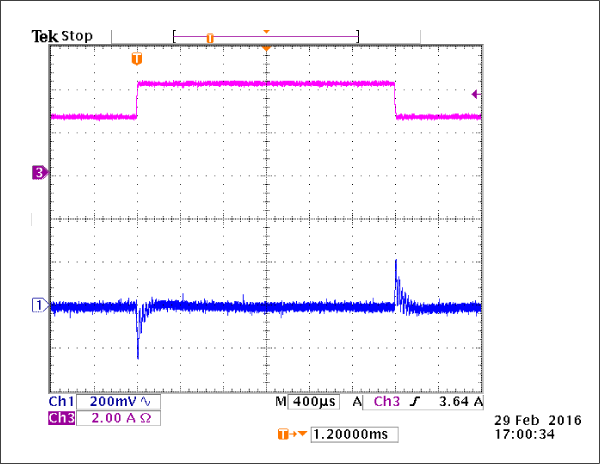MAXREFDES115#: Isolated 24V to 5V 20W Power Supply
Maxim’s power supply experts have designed and built a series of isolated, industrial power supply reference designs. Each of these power supplies efficiently converts 24V into useful voltage rails at a variety of power levels. Every power rail is isolated with a readily available transformer from multiple, global vendors, providing for quick, convenient transformer selection. Each design has been tested for load and line regulation, as well as efficiency and transient performance.
MAXREFDES115# is an efficient active clamp topology design with 24V input, and a 5V at 4A (20W) of power. The design features the MAX17599, an active clamp, current-mode PWM controller optimized for industrial supplies; this entire circuit fits on a 20mm x 55mm board. As with all Maxim reference designs, the BOM, schematics, layout files, Gerber files are all available. In addition, all boards feature through-hole pins for immediate board placement and accelerated prototyping, and are available for purchase.
Features
- Functional Insulation
- Compact and Flexible
- Low Power Dissipation
- Minimal External Components
- Robust Operation in Adverse Industrial Environments
- 5V at 4A Output with 20% Over-Range Current
Applications
- PLCs
- Industrial Process Control and Sensors
- Telecom and Datacom Power Supplies
详情介绍
Introduction
Though isolated power supplies provide reliable power regulation for a variety of applications, transformer selection is often the most difficult step in isolated power design. The MAXREFDES115# is a compact, isolated 24V input active clamp converter module that features 5V at 4A (20W) output. Multiple transformers have been qualified for this design, simplifying the process of transformer selection. In addition, through-hole pins on the bottom side of the module allow quick and easy integration of this power converter into any system. Pins are 15.24mm from power to ground, and 63.5mm from the input side to the output side.
The MAXREFDES115# reference design (Figure 1) demonstrates the application of the MAX17599 low IQ, wide-input range, active-clamp current-mode PWM controller. The MAX17599 contains all the control circuitry required for the design of wide-input isolated forward-converter industrial power supplies. The reference design features the active-clamp transformer reset topology for forward converters. This reset topology has several advantages including reduced voltage stress on the switches, transformer size reduction due to larger allowable flux swing, and improved efficiency due to elimination of dissipative snubber circuitry. These features result in a compact and cost-effective isolated power supply. The design is set to switch at 250kHz. For EMI-sensitive applications, the user can program the frequency-dithering scheme, enabling low-EMI spread-spectrum operation.
The input undervoltage lockout (EN/UVLO) is provided for programming the input-supply start voltage (set to 16.5V in the design) and to ensure proper operation during brownout conditions. The EN/UVLO input is also used to turn on/off the IC. The overvoltage input (OVI) protection scheme is provided to make sure that the controller shuts down when the input supply exceeds the maximum allowed value (set to 37.0V in the design).
To control inrush current, the device incorporates a soft-start (SS) pin to set the soft-start time for the regulator. Power dissipation under fault conditions is minimized by hiccup overcurrent protection (hiccup mode). The SS feature provides safe discharging of the clamp capacitor when the device is turned off, and allows the controller to restart in a well-controlled manner.
Additionally, the negative current limit is provided in the current-sense circuitry, helping limit clamp switch current under dynamic operating conditions. An overtemperature fault triggers thermal shutdown for reliable protection of the device. The reference design delivers a peak efficiency of 91.5% with the supplied components when the input is 24V. This general-purpose power solution can be used in many different types of power applications, such as programmable logic controllers (PLC), industrial process control, industrial sensors, telecom/datacom power supplies, isolated battery chargers, servers, and embedded computing.
System Diagram
 Figure 1. MAXREFDES115# reference design block diagram.
Figure 1. MAXREFDES115# reference design block diagram.
Detailed Circuit Description
The MAX17599 low IQ active-clamp current-mode PWM controller contains all the control circuitry required for designing wide-input isolated forward-converter industrial power supplies.
The device includes an AUX driver that drives an auxiliary MOSFET (clamp switch) that helps implement the active-clamp transformer reset topology for forward converters. This reset topology has several advantages, including reduced voltage stress on the switches, transformer size reduction due to larger allowable flux swing, and improved efficiency due to elimination of dissipative snubber circuitry. Programmable dead time between the AUX and main driver allows for zero voltage switching.
Primary Power Stage
The active-clamp transformer primary side is driven by an n-channel MOSFET (N1) and a p-channel MOSFET (P1). While N1 is on, power is delivered to the secondary, and magnetizing energy is being stored in the transformer. During this time, P1 is off, and the clamp capacitor (C12) is charged at a constant voltage level.
When N1 turns off, the leakage and magnetizing currents charge up the drain-to-source capacitance of N1. Once the drain-to-source voltage of N1 exceeds the voltage across the clamp capacitor, the body diode of P1 begins to conduct. With the body diode of P1 conducting, the magnetizing current begins to charge the clamp capacitor.
After the body diode of P1 conducts, P1 turns on. This provides zero current switching for P1. The clamp capacitor continues to charge until the magnetizing current is reduced to 0A. At this point, the magnetizing current reverses, and the clamp capacitor begins to discharge until the P1 turns off.
After P1 turns off, the clamp capacitor remains at a fixed voltage. There is a fixed delay before N1 turns on. During this delay, the energy in the parasitic components discharges the VDS of N1 towards VIN. This allows softer turn on and lower switching losses for N1.
The MAX17599 NDRV pin drives N1 while the AUXDRV pin is level shifted through C11, R14, and D4, and then drives P1.
Secondary Power Stage
The secondary power stage consists of the synchronous rectifiers (N1, N2), and the output filters (L2, C4, C5, C6).
When the primary n-FET (N3) is turned ON, the input power is transferred instantaneously to the output through forward conducting MOSFET N2. During the turn-off period, the output inductor current freewheels through MOSFET N1.
The voltage on the input end of the filter inductor is a typical buck converter square wave. The inductor and output capacitors filter the square wave to produce a DC voltage on the output.
Feedback Control Loop
The feedback network is constructed using a TLV431B programmable shunt regulator, a 3000V isolation optocoupler, and other RC components.
Startup Voltage and Input Overvoltage Protection Setting (EN/UVLO, OVI)
The EN/UVLO pin in the MAX17599 serves as an enable/disable input, as well as an accurate programmable under voltage lockout (UVLO) pin. The MAX17599 does not begin startup operations unless the EN/UVLO pin voltage exceeds 1.21V (typ). The MAX17599 turns off if the EN/UVLO pin voltage falls below 1.15V (typ). A resistor divider from the input DC bus to ground can be used to divide down and apply a fraction of the input DC voltage to the EN/UVLO pin. The values of the resistor divider can be selected so that the EN/UVLO pin voltage exceeds the 1.21V (typ) turn on threshold at the desired input DC bus voltage. The same resistor divider can be modified with an additional resistor, ROVI, to implement overvoltage input protection in addition to the EN/UVLO functionality. When the voltage at the OVI pin exceeds 1.21V (typ), the MAX17599 stops switching. Switching resumes with soft-start operation, only if the voltage at the OVI pin falls below 1.15V (typ).
Quick Start
Required equipment:
- MAXREFDES115#
- One adjustable DC power supply with voltage output up to 36V and current up to 3A
- One electronic load
- Two voltmeters
- Two ammeters
Procedure
The MAXREFDES115 board is fully assembled and tested. Use the following steps to verify board operation.
- Turn off the power supply.
- Connect the positive terminal of the power supply to the VIN connector of the MAXREFDES115# board.
- Connect the GND connector of the MAXREFDES115# board to the positive terminal of one ammeter. Connect the negative terminal of the ammeter to the negative terminal of the power supply.
- Connect one voltmeter across the VIN and the GND connectors of the MAXREFDES115# board.
- Connect the VOUT connector of the MAXREFDES115# board to the positive terminal of the electronic load.
- Connect the negative terminal of the electronic load to the positive terminal of the second ammeter. Connect the negative terminal of the ammeter to the PGNDO connector of the MAXREFDES115# board.
- Connect the second voltmeter across the VOUT and the PGNDO connectors of the MAXREFDES115# board.
- Turn on the power supply. Set the output to 24V.
- Set the electronic load to a constant current between 0A to 4A.
- Verify the second voltmeter reading is 5V ±0.25V.
Lab Measurements
The MAXREFDES115# was verified and tested under full input range and different output load conditions. The power efficiency vs. load current is illustrated in Figure 2.
 Figure 2. Power efficiency vs. load current for MAXREFDES115A# at 5VOUT, other versions performed similarly.
Figure 2. Power efficiency vs. load current for MAXREFDES115A# at 5VOUT, other versions performed similarly.
Figure 3 displays the output ripple at full load when the input is 24V.
 Figure 3. Transient response when load steps from 5mA to 1600mA.
Figure 3. Transient response when load steps from 5mA to 1600mA.
Figure 4 displays the load transient response when the load is stepped from 5mA to 1600mA, and then dropped back to 5mA again. The output transient spike is about 240mV. The input is 24V.
 Figure 4. Output ripple at 4A load, 5VOUT.
Figure 4. Output ripple at 4A load, 5VOUT.
Figure 5 shows the load transient response when the load is stepped from 2.4A to 4A, and then dropped back to 2.4A again. The input is 24V.
 Figure 5. Transient response when load steps from 2.4A to 4A, at 5VOUT.
Figure 5. Transient response when load steps from 2.4A to 4A, at 5VOUT.








